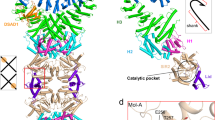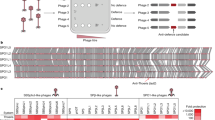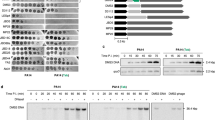Abstract
Defence-associated sirtuins (DSRs) comprise a family of proteins that defend bacteria from phage infection via an unknown mechanism. These proteins are common in bacteria and harbour an N-terminal sirtuin (SIR2) domain. In this study we report that DSR proteins degrade nicotinamide adenine dinucleotide (NAD+) during infection, depleting the cell of this essential molecule and aborting phage propagation. Our data show that one of these proteins, DSR2, directly identifies phage tail tube proteins and then becomes an active NADase in Bacillus subtilis. Using a phage mating methodology that promotes genetic exchange between pairs of DSR2-sensitive and DSR2–resistant phages, we further show that some phages express anti-DSR2 proteins that bind and repress DSR2. Finally, we demonstrate that the SIR2 domain serves as an effector NADase in a diverse set of phage defence systems outside the DSR family. Our results establish the general role of SIR2 domains in bacterial immunity against phages.
This is a preview of subscription content, access via your institution
Access options
Access Nature and 54 other Nature Portfolio journals
Get Nature+, our best-value online-access subscription
$29.99 / 30 days
cancel any time
Subscribe to this journal
Receive 12 digital issues and online access to articles
$119.00 per year
only $9.92 per issue
Buy this article
- Purchase on Springer Link
- Instant access to full article PDF
Prices may be subject to local taxes which are calculated during checkout




Similar content being viewed by others
Data availability
Data that support the findings of this study are available within the Article and its Extended Data. Gene accessions appear in the Methods section of the paper. Plasmid maps of the constructs used for the experiments are attached as Supplementary Files. Source data are provided with this paper.
References
North, B. J. & Verdin, E. Protein family review Sirtuins: Sir2-related NAD-dependent protein deacetylases. Genome Biol. 5, 224 (2004).
Imai, S., Armstrong, C. M., Kaeberlein, M. & Guarente, L. Transcriptional silencing and longevity protein Sir2 is an NAD-dependent histone deacetylase. Nature 403, 795–800 (2000).
Tanny, J. C., Dowd, G. J., Huang, J., Hilz, H. & Moazed, D. An enzymatic activity in the yeast Sir2 protein that is essential for gene silencing. Cell 99, 735–745 (1999).
Dang, W. & Pfizer, N. C. The controversial world of sirtuins. Drug Discov. Today Technol. 12, e9–e17 (2014).
Makarova, K. S., Wolf, Y. I., van der Oost, J. & Koonin, E. V. Prokaryotic homologs of Argonaute proteins are predicted to function as key components of a novel system of defense against mobile genetic elements. Biol. Direct 4, 29 (2009).
Doron, S. et al. Systematic discovery of antiphage defense systems in the microbial pangenome. Science 359, eaar4120 (2018).
Ofir, G. et al. Antiviral activity of bacterial TIR domains via signaling molecules that trigger cell death. Nature 600, 116–120 (2021).
Gao, L. et al. Diverse enzymatic activities mediate antiviral immunity in prokaryotes. Science 369, 1077–1084 (2020).
Lopatina, A., Tal, N. & Sorek, R. Abortive infection: Bacterial suicide as an antiviral immune strategy. Annu. Rev. Virol. 7, 371–384 (2020).
Kohm, K. & Hertel, R. The life cycle of SPβ and related phages. Arch. Virol. 166, 2119–2130 (2021).
Noyer-Weidner, M., Jentsch, S., Pawlek, B., Günthert, U. & Trautner, T. A. Restriction and modification in Bacillus subtilis: DNA methylation potential of the related bacteriophages Z, SPR, SP beta, phi 3T, and rho 11. J. Virol. 46, 446–453 (1983).
Dragoš, A. et al. Pervasive prophage recombination occurs during evolution of spore-forming Bacilli. ISME J. 15, 1344–1358 (2021).
Bernheim, A. et al. Prokaryotic viperins produce diverse antiviral molecules. Nature 589, 120–124 (2021).
Freire, D. M. et al. An NAD+ phosphorylase toxin triggers mycobacterium tuberculosis cell death. Mol. Cell 73, 1282–1291.e8 (2019).
Morehouse, B. R. et al. STING cyclic dinucleotide sensing originated in bacteria. Nature 586, 429–433 (2020).
Skjerning, R. B., Senissar, M., Winther, K. S., Gerdes, K. & Brodersen, D. E. The RES domain toxins of RES-Xre toxin-antitoxin modules induce cell stasis by degrading NAD. Mol. Microbiol. 111, 221–236 (2019).
Tang, J. Y., Bullen, N. P., Ahmad, S. & Whitney, J. C. Diverse NADase effector families mediate interbacterial antagonism via the type VI secretion system. J. Biol. Chem. 293, 1504–1514 (2018).
Tal, N. et al. Cyclic CMP and cyclic UMP mediate bacterial immunity against phages. Cell 184, 5728–5739.e16 (2021).
Millman, A. et al. Bacterial retrons function in anti-phage defense. Cell 183, 1551–1561.e12 (2020).
Kaufmann, G. Anticodon nucleases. Trends Biochem. Sci. 25, 70–74 (2000).
Depardieu, F. et al. A eukaryotic-like serine/threonine kinase protects staphylococci against phages. Cell Host Microbe 20, 471–481 (2016).
Millman, A. et al. An expanding arsenal of immune systems that protect bacteria from phages. Preprint at bioRxiv https://doi.org/10.1101/2022.05.11.491447 (2022).
Cohen, D. et al. Cyclic GMP–AMP signalling protects bacteria against viral infection. Nature 574, 691–695 (2019).
Overkamp, W. et al. Benchmarking various green fluorescent protein variants in Bacillus subtilis, Streptococcus pneumoniae, and Lactococcus lactis for live cell imaging. Appl. Environ. Microbiol. 79, 6481–6490 (2013).
Wilson, G. A. & Bott, K. F. Nutritional factors influencing the development of competence in the Bacillus subtilis transformation system. J. Bacteriol. 95, 1439–1449 (1968).
Mazzocco, A., Waddell, T. E., Lingohr & E, J. R. Enumeration of bacteriophages using the small drop plaque assay system. Methods Mol. Biol. 501, 81–85 (2009).
Baym, M. et al. Inexpensive multiplexed library preparation for megabase-sized genomes. PLoS ONE 10, e0128036 (2015).
Prjibelski, A., Antipov, D., Meleshko, D., Lapidus, A. & Korobeynikov, A. Using SPAdes De Novo Assembler. Curr. Protoc. Bioinforma. 70, 1–29 (2020).
Gilchrist, C. L. M. & Chooi, Y.-H. Clinker & Clustermap.Js: automatic generation of gene cluster comparison figures. Bioinformatics 37, 2473–2475 (2021).
Gabler, F. et al. Protein sequence analysis using the MPI bioinformatics toolkit. Curr. Protoc. Bioinforma. 72, 1–30 (2020).
Zaremba, M. et al. Sir2-domain associated short prokaryotic Argonautes provide defence against invading mobile genetic elements through NAD+ depletion. Preprint at bioRxiv https://doi.org/10.1101/2021.12.14.472599 (2021).
Altschul, S. F. et al. Gapped BLAST and PSI-BLAST: a new generation of protein database search programs. Nucleic Acids Res. 25, 3389–3402 (1997).
Acknowledgements
We thank the Sorek laboratory members for comments on the manuscript and fruitful discussion. We also thank A. Brandis and T. Mehlman from the Weizmann Life Sciences Core Facilities for targeted mass spectrometry analyses, and A. Savidor from the Israel National Center for Personalized Medicine for protein mass spectrometry. R.S. was supported, in part, by the European Research Council (grant nos. ERC-CoG 681203 and ERC-AdG GA 101018520), Israel Science Foundation (grant no. ISF 296/21), the Ernest and Bonnie Beutler Research Program of Excellence in Genomic Medicine, the Deutsche Forschungsgemeinschaft (SPP 2330, grant no. 464312965), the Minerva Foundation with funding from the Federal German Ministry for Education and Research and the Knell Family Centre for Microbiology. V.S. was supported by the European Social Fund (grant no. 09.3.3-LMT-K-712-01-0126) under a grant agreement with the Research Council of Lithuania (LMTLT).
Author information
Authors and Affiliations
Contributions
J.G. and R.S. led the study and performed all analyses and experiments unless otherwise indicated. A. Lopatina performed plaque assay experiments with the SIR2/pAgo defence system. A.B. cloned and conducted plaque assays for the pVip defence system. M.Z. and V.S. provided the SIR2/pAgo defence system. S.M. and A. Leavitt cloned and conducted plaque assays for the DSR2, DSR1 and SIR2-HerA defence systems. A.M. and G.A. assisted with sequence analysis and prediction of protein domain functions and point mutations. The manuscript was written by J.G. and R.S. All authors contributed to editing the manuscript, and support the conclusions.
Corresponding author
Ethics declarations
Competing interests
R.S. is a scientific cofounder and advisor of BiomX and Ecophage. The other authors declare no competing interests.
Peer review
Peer review information
Nature Microbiology thanks Lennart Randau, Malcolm White and the other, anonymous, reviewer(s) for their contribution to the peer review of this work.
Additional information
Publisher’s note Springer Nature remains neutral with regard to jurisdictional claims in published maps and institutional affiliations.
Extended data
Extended Data Fig. 1 Exemplary plaque assay results showing DSR2 defence.
Plaque assay with tenfold serial dilution of phage SPR on the control B. subtilis strain (no system) or B. subtilis with DSR2.
Extended Data Fig. 2 Phage SPR does not replicate in high MOI infection of DSR2-containing cells.
Titre of phage SPR at different time points following infection of the control B. subtilis strain (no system) or B. subtilis with DSR2. Data represent plaque-forming units (PFU) per millilitre. Bar graphs represent average of three independent replicates, with individual data points overlaid.
Extended Data Fig. 3 pVip alone protects against phi3T and SPbeta but not against SPR.
Efficiency of plating (EOP) for three phages infecting the control B. subtilis strain (no system) or B. subtilis with pVip cloned from Fibrobacter sp. UWT3. Data represent plaque-forming units (PFU) per millilitre. Bar graphs represent average of three independent replicates, with individual data points overlaid. Control data are the same as those presented in Fig. 1b.
Extended Data Fig. 4 Testing of candidate genes for inhibition and activation of DSR2.
Legend of genes and operons tested included above. (a) Liquid culture growth of B. subtilis BEST7003 cells expressing either DSR2 alone, or DSR2 and a candidate gene, or control cells expressing neither gene, infected by phage SPR at 30 °C. Bacteria were infected at time 0 at an MOI of 0.04. Three independent replicates are shown for each MOI, and each curve shows an individual replicate. Each panel shows a different candidate gene. The ‘No system’ and the DSR2 control curves are the same for all 5 panels. (b, c) Transformation efficiencies of a vector containing operon 1-3 (panel B), or 4 individual genes from operon 3 (panel C) were measured for cells containing WT DSR2. Y axis represents the number of colony-forming units per millilitre obtained following transformation. Bar graphs represent average of three replicates, with individual data points overlaid.
Extended Data Fig. 5 The tail tube does not pull down DSR2 when DSAD1 is co-expressed.
Pulldown assays of the DSR2-tail tube complex, heterologously expressed in E. coli. The tail tube protein of phage SPR was C-terminally tagged with TwinStrep tag. DSR2 in this experiment was mutated (H171A) to avoid toxicity. Shown is an SDS-PAGE gel. Lane A, cells expressing tagged tail tube protein from SPR, DSR2 (H171A) and GFP. Lane B, cells expressing tagged tail tube protein from SPR, DSR2 (H171A) and DSAD1.
Extended Data Fig. 6 Multiple sequence alignment comparing the tail tube protein of SPR and SPbeta/phi3T.
The NCBI accessions for the SPR and phi3T/SPbeta tail tube proteins are WP_010328117 and WP_004399252, respectively (the phi3T tail tube protein is identical to that of SPbeta). Protein amino acid sequences were aligned by Clustal Omega30.
Extended Data Fig. 7 SIR2-containing defence systems protect against multiple phages.
a-d. Efficiency of plating (EOP) for multiple phages infecting control bacteria (no system) or bacteria expressing defence systems. Data represent plaque-forming units (PFU) per millilitre. Bar graphs represent average of three independent replicates, with individual data points overlaid. KAW1E185 is short for vB_EcoM-KAW1E185, a T4-like phage. Data appearing in this figure also appear in Fig. 4b. Data for control samples are the same in panels A and D. Asterisk marks statistically significant decreases (Student’s t-test, two-sided, P values = 0.020, 0.005, 0.036, 0.014, for phages SPR with DSR2, lambda (vir) with SIR2/pAgo, KAW1E185 with SIR2-HerA, phi29 with DSR1, respectively).
Extended Data Fig. 8 Testing for defence in mutants of SIR2/pAgo, SIR2-HerA and DSR1.
a-c. Efficiency of plating (EOP) for phages infecting the control strain (no system), bacteria containing the WT defence system, and bacteria containing mutants of the defence system. In all cases except for pAgo, point mutations were introduced in the predicted active site of the protein. For the pAgo, a bulky HSH tag, which was shown in another study to inactivate the protein31, was added to the C-terminus. Data represent plaque-forming units (PFU) per millilitre. Bar graphs represent average of three independent replicates, with individual data points overlaid. Asterisk marks statistically significant decreases (Student’s t-test, two-sided, P values = <0.001, 0.002, <0.001, for phages lambda (vir) with SIR2/pAgo, KAW1E185 with SIR2-HerA, phi29 with DSR1, respectively).
Extended Data Fig. 9 DSR1 and DSR2 alignment is limited to the SIR2 domain. SPR tail tube does not activate DSR1.
(a) Graphical representation of running BLASTP32 with a query of DSR2 and subject of DSR1. The red area spans an alignment with 23.29% identity and an E value of 9e-07. The rest of the protein is not alignable. The red bracket above indicates the predicted SIR2 domain. (b) Transformation efficiencies of a vector containing the SPR tail tube protein were measured for cells containing either DSR1 or an inactive DSR2 mutant (H171A) as control. The y axis represents the number of colony-forming units per millilitre. Bar graphs represent average of three replicates, with individual data points overlaid.
Supplementary information
Supplementary Data 1
Genomes of hybrids used in this study.
Supplementary Data 2
Plasmid file.
Supplementary Data 3
Plasmid file.
Supplementary Data
Primers used in this study.
Source data
Source Data Fig. 1
Source data.
Source Data Fig. 3
Uncropped gel image.
Source Data Fig. 3
Source data.
Source Data Fig. 4
Source data.
Source Data Extended Data Fig. 2
Source data.
Source Data Extended Data Fig. 3
Source data.
Source Data Extended Data Fig. 4
Source data.
Source Data Extended Data Fig. 5
Uncropped gel image.
Source Data Extended Data Fig. 7
Source data.
Source Data Extended Data Fig. 8
Source data.
Source Data Extended Data Fig. 9
Source data.
Source Data Extended Data Fig. 9
BLAST alignment.
Rights and permissions
Springer Nature or its licensor holds exclusive rights to this article under a publishing agreement with the author(s) or other rightsholder(s); author self-archiving of the accepted manuscript version of this article is solely governed by the terms of such publishing agreement and applicable law.
About this article
Cite this article
Garb, J., Lopatina, A., Bernheim, A. et al. Multiple phage resistance systems inhibit infection via SIR2-dependent NAD+ depletion. Nat Microbiol 7, 1849–1856 (2022). https://doi.org/10.1038/s41564-022-01207-8
Received:
Accepted:
Published:
Issue Date:
DOI: https://doi.org/10.1038/s41564-022-01207-8
This article is cited by
-
Auto-inhibition and activation of a short Argonaute-associated TIR-APAZ defense system
Nature Chemical Biology (2024)
-
Inhibitors of bacterial immune systems: discovery, mechanisms and applications
Nature Reviews Genetics (2024)
-
Conservation and similarity of bacterial and eukaryotic innate immunity
Nature Reviews Microbiology (2024)
-
Activation of Thoeris antiviral system via SIR2 effector filament assembly
Nature (2024)
-
Anti-phage defence through inhibition of virion assembly
Nature Communications (2024)



